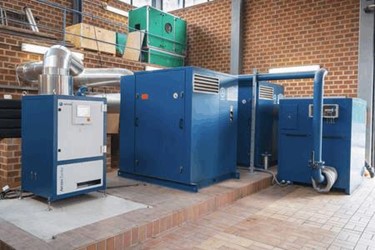WWEMA Window: The Evolution Of High Speed Turbo In The Wastewater Industry
By Tom McCurdy, Aerzen USA

High speed turbo (HST) technology was the most quickly adopted blower design to enter the U.S. wastewater market. HST appeared in 2006, at a time when there was a need for more efficient plant operation. There were several energy incentive programs available, especially on the East and West Coasts, where power was more expensive ($.10 to $.25/kWh). The energy required for wastewater aeration amounts to over 50 percent of the energy bill for a municipal treatment works, which made energy-efficient blowers even more attractive. The incentives were structured to offset the extra cost for more expensive, more efficient technologies, based on a lifecycle evaluation that factored the operating costs over a 20-year machine life. Since turbo blowers could be as much as 30 percent more efficient than the existing technologies, they were relatively easy to justify. Turbo sales took off. Aerzen initially did not have a turbo technology to offer. At the time, Aerzen was evaluating the K-Turbo technology in Europe, but a decision had not yet been made to pursue it (not until 2010). We experienced a significant drop in sales of our positive displacement blowers, especially the larger machines, as turbo blowers were being purchased as a more efficient option.
With the profusion of economic incentives, HST was heavily applied. In many cases, the technology was applied without considering its suitability in the system. As a new technology, there was still a lot to learn, and many mistakes were made by manufacturers and engineers during its early implementation. Some manufacturers were crippled by product design issues. Other manufacturers made poor business decisions (e.g., American Recovery and Reinvestment Act compliance, limited size availability).
In the years that followed, the wastewater community became cautious of the technology, based on the difficulties which occasionally resulted in completely failed installations. The common thread remained that this electronics-intense technology was not completely understood by an engineering community with mechanical, civil, and environmental backgrounds. Whether it was the experience of the consultant on a particular project, or the overall opinion of the “go-to” engineer of a larger firm, collective opinions formed. The level of concern boiled down to two misconceptions:
- High Speed Turbo blowers were too troublesome for wastewater applications.
- Airfoil bearings were less robust than magnetic bearings.
Several manufacturers benefited from this misinformation. Aerzen and some other manufacturers have the ability to offer a high-efficiency alternative, a low-pressure screw blower, to replace HST. Manufacturers using magnetic bearings offered their product as “more robust” than airfoil HST. Even the less-efficient multistage centrifugal blowers experienced renewed popularity.
As much as the difficulties gained attention, the majority of installations for the major HST manufacturers (regardless of bearing type) are, and continue to be, successful. The properly implemented projects are enjoying reduced electrical costs, quiet operation, and minimal maintenance. The manufacturers that emerged as the leaders continue to commit resources to refine their products.
The reality is that turbo blowers should be considered wherever the variables of the process permit them to be used. The energy savings, small footprint, and easy maintenance are undeniable.
Manufacturers that offer more than one technology can evaluate the process to ensure turbo can be used easily and effectively. Guidance on proper selection, installation, and control are critical to success. Specifically, these items must be addressed by the manufacturer:
- Best processes served by turbo
- Installation factors: indoor or outdoor, proper cooling, process piping configuration
- Electrical considerations: harmonics, ambient temperature limits
- Control: seasonal changes in turndown, operating multiple units, mixed technologies in the same system, types of control (pressure- or flow-based)
High Speed Turbo technology is a powerful technology that continues to evolve. When properly applied, it can deliver big benefits.
Tom McCurdy is Sales Manager at Aerzen USA based in Coatesville, PA, a Water and Wastewater Equipment Manufacturers Association (WWEMA) member company. Since 1908, WWEMA has informed, educated, and provided leadership on the issues that shape the future of the water and wastewater industry. Its member companies supply the most sophisticated leading-edge products and technologies, offering solutions to every water-related environmental problem and need facing today’s society. For more information, go to www.wwema.org.
